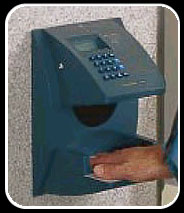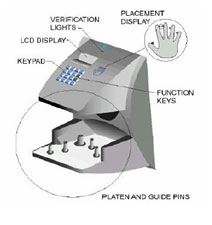 Description
Description
The HandKey utilizes 3 dimensional hand geometry to verify a person’s identity and is primarily designed for access control applications. The unit has an integrated keypad and LCD. It can be used in a standalone or networked mode. Built in inputs and outputs allow for door lock control and monitoring. Time restrictions are also supported. Card reader emulation mode allows for simple integration to proximity,
wiegand, magnetic stripes or bar code based access control systems. The HandKey can store over 27,000 users in internal memory due to the industry’s smallest template size, 9 bytes. Options include internal modem, various card readers for ID number input, smart card readers, and an outdoor version.
HandPunch Technology
The HandPunch uses the size and the shape of the human hand to verify a person's identity. It does not read fingerprints or the palm. The reader takes over 90 measurements of the fingers and part of the hand. The hand reader uses invisible light like the kind used in a television remote control, special optics and a CCD (chip) camera to capture a three-dimensional image of the hand.
Using advanced microprocessor technology, the terminal converts the image to a template. It stores the template in database with the employee’s ID number.
To punch in, the employee enters his or her ID number at the terminal. HandPunch 2000 prompts the employee to place his or her hand. The terminal compares the hand on the platen with employee’s unique template. If the images match, the terminal stores the punch information and uploads it to time and attendance software for processing.
 The Recognition Systems verifies a person’s identity by looking at their unique hand geometry. Hand Geometry is the measurement of the size and shape of a hand. It includes
The Recognition Systems verifies a person’s identity by looking at their unique hand geometry. Hand Geometry is the measurement of the size and shape of a hand. It includes
length, width, thickness, and surface area of the four fingers and the hand. To do this, an infrared light is used in conjunction with a 32,000pixel CCD image array. The CCD image array is similar to those used in a common video camera. The infrared light is the same as what is used in a television remote control. The light illuminates the hand allowing the image to be capture by the CCD image array. The image is then used to determine the length of each finger, it’s width at several locations, the surface area near the knuckles, and the thickness of the fingers. In total, over 90 measurements defining the shape of the hand are derived from the image.
The measurements are then further processed to determine what are the unique characteristics of the hand. These unique features are then used to create the 9 byte template that is used for subsequent comparisons.
When an individual is enrolled in the HandKey, a template is created and stored in memory along with their ID number. The template becomes the reference template for future verification attempts. When the person uses the HandKEy, they enter their ID number. The template associated with that ID number is brought into the HandKey’s comparison memory. The user is prompted to place their hand and a template is created for that hand. This template is compared against the reference template to determine a “goodness
of fit” of the two templates. The result of the comparison is called the score. The greater the number of differences between the two templates, the greater the score. The opposite is also true. If the number of differences is low, so is the score. If the resulting score is lower than the set reject threshold, the user us verified. If the score exceeds the reject threshold, the user is rejected.